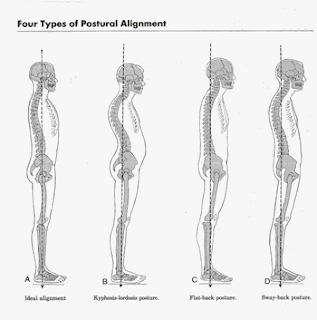Do you have aches and pains and wonder if your posture is the source of the problem? If yes, Kate Smith
from Bodhi Osteopathy and I are here to help you work out your posture types
and how you can achieve an ideal posture to stay from musculoskeletal
problems.
The 4 main stereotypical posture alignments are Ideal Alignment, Kyphotic/Lordotic, Flat Back and Sway Back.
Kate & Chloe’s everyday tips to help correct your lordosis:
The 4 main stereotypical posture alignments are Ideal Alignment, Kyphotic/Lordotic, Flat Back and Sway Back.
Kyphosis
In today’s world our bodies spend far too
much time in environments that do not promote general well-being. Life can be
very static and we often find ourselves spending long hours hunched over the
computer or slumped in front of the TV. Kyphosis, or hunchback, is an
unbalanced posture that can cause neck and back pain. The head is pushed forward;
the upper back is rounded, increasing the flexion of the thoracic spine. Hip
flexors, Quads and Gluteal muscles are also shortened and tightened.
Kate & Chloe’s everyday tips to
help correct your Kyphosis:
· Stretch the chest muscles
· Think about gently drawing your
shoulders back and down
· Work on strengthening the rhomboid
muscles (muscle between the shoulder blades). To strengthen the
rhomboids, you want to perform any exercise that involves squeezing the
shoulder blades together
· Stretch
your hip flexors, Quads and Gluteal muscles.
· Ensure
that your ergonomic set up at home at work is correct. (Further advice can be given by Kate to make
sure you are achieving this)
Lordosis
Lordosis
is a back posture that exaggerates the lumbar curve (lower back) and an anterior
pelvic tilt, when the pelvis
tips forward when resting on top of the femurs. This can lead to excess
pressure on the spine, causing pain. In addition to this, slightly hyper
extended knee joints, tight lower
back muscles, weak hamstrings, tight hip flexors also
occur. Obesity, and pregnancy can also contribute to causing Lordosis.Kate & Chloe’s everyday tips to help correct your lordosis:
- Strengthen hamstrings, glutes and core muscles (see Chloe’s blog posts for exercises)
- Stretch hip flexors and lower back (in flexion)
- Think about slightly tucking the tail bone under when standing
- Strengthening core muscles to strengthen the lower back (Pilates is a good method to achieve this)
Sway-back
Sway back is another name for Lordosis. The slight
difference is that the pelvis is posterially tilted and the knee joints are
hyper extended. The lower back is also flatter.
Kate & Chloe’s everyday tips to
help correct your sway-back:
- Stretch the lower and upper back into extension.
- Think about sticking your tail bone out whist standing.
- Stretch hip flexors, Gluteal muscles
and Quads.
Flat-back
Flat back posture is exactly how it sounds. The head is
slightly held forward. The upper part of the Thoracic spine is flexed as the
lower part is flexed. The hip and knee joints are also extended.
Kate & Chloe’s everyday tips to
help correct your flat-back:
- Strengthen the hip flexors
- Stretch hamstrings and calves.
- Stretch the Thoracics and Lower back in extension.
Ideal
Alignment
After all
this information, I am sure you are wondering what exactly is the “ideal
posture” and how is this achieved.
The green dot running
vertically in the picture above is called the plumb line. Ideally, the plumb
line should pass through the ear lobe and straight down.
Kate & Chloe’s everyday
tips to help achieve this Ideal Alignment;
When standing, imagine a
piece of string being pulled from the top of your head. Elongate your neck and
slightly tuck your chin in. Shoulders should be down and relaxed with arms
hanging naturally at the side of your body. Knees should be slightly “soft”
with your tail bone slightly tucked under. If this feels unnatural/causes any
pain or discomfort then please do not hesitate to contact us as this may be due
to a number of anatomical problems which can be assessed and corrected.




No comments:
Post a Comment